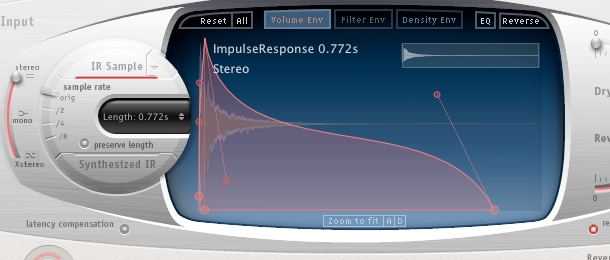
Convolution reverbs have become vastly more popular in recent years. The increased processing power of the average, up-to-date PC has made this fairly intensive processing more feasible. Although their use is a little more fiddly than the old, familiar digital simulation-type reverbs, convolution reverbs allow us to effectively place dry sounds in real acoustic spaces, which have been sampled via a simple recording of an impulse response.
Acting On Impulse
The idea is quite straightforward: use a speaker in a room (or any reverberant space) to play back a very short burst of white noise (or use a pistol, or pop a balloon). This burst is our 'impulse'. Record the sound of the impulse bouncing around in the reverberant space - this is our 'impulse response'. Use an FFT-based filter (effectively a graphic EQ with thousands of very narrow bands, automatically set by analysis of your recorded impulse response) to filter the sound you want to process in the same way as the room filtered your impulse.
This is the sort of recording you end up with:
Now here is an example drum loop made entirely with dry samples, excepting some reverb added to the snare drum:
In a convolution reverb plugin we can now apply our impulse response to the input signal, our drum loop in this example, to produce the effect of having recorded this drum loop in a live space:
What's interesting for our purposes, however, is that the impulse response used by the convolution reverb is simply an audio file - which leaves the door open for us to load in any audio file or sample we like.
When Two Become One...
Most convolution reverbs (such as Logic's Space Designer, Waves IR-1, Altiverb, and so on) allow us to load in our own recorded impulse responses, instead of one from the usual library of impulse responses included with the software. No matter what kind of audio we load in, the convolution reverb will still process the dry signal as though the sample we loaded was actually an impulse response. This means that our dry signal will be filtered by the other, and so take on some of the spectral characteristics of our sample.
Here's a more unusual recording to use as an impulse response:
This is a recording of a stone slab being hit with a stick. You can of course use more textural sounds with a less defined amplitude envelope as your impulse but the input signal will become harder to discern - in the following example, the characteristics of the slab sound can be clearly heard, as well as those of our drum loop:
Hear how the drum loop takes on properties of the slab recording' What's more, this is an incredibly easy and interesting effect to achieve!
Sky's The Limit
Convolution reverb units thus offer us two things: firstly, the ability to realistically place sounds into spaces that they were not originally recorded in and secondly, a pretty radical sound morphing capability. Your imagination really is the limit here and there's no hard and fast rules for what will and won't work. Try convolving drums with old synth sounds; vocals with natural ambience recordings; percussion top loops with basslines - the results can be startling!
Check out our complete range of SFX, texture and ambient sounds to get your convolution experiments off the ground.














